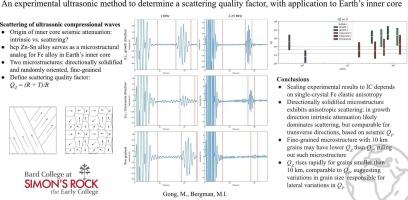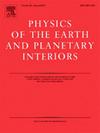一种测定散射品质因子的实验超声方法,并应用于地核
IF 1.9
3区 地球科学
Q2 GEOCHEMISTRY & GEOPHYSICS
引用次数: 0
摘要
地震衰减可以是固有的,也可以是由于散射引起的。它们对地球内核的相对作用是不确定的。虽然本征衰减主要取决于材料、温度和压力,但散射主要是微观结构的函数,即晶粒尺寸、形状、织构以及单晶弹性各向异性。在这里,我们实验研究了超声波纵波在六方紧密堆积(hcp)富锌锡合金中的散射,研究了两种可能与内核相关的微观结构:典型定向凝固的织构大柱状枝晶,以及可能由扩散蠕变产生的非织构等轴细晶。我们还研究了这两种微结构散射与波长/晶粒尺寸的关系。我们使用富锌的Sn合金并不是因为我们期望它在内核条件下具有类似于Fe的固有衰减,而是因为它的hcp晶体结构是内核中Fe合金的可能相,这使得它适合于理解微观结构对内核散射的作用。为了将实验扩展到内核,压力和温度主要通过对铁的弹性常数和内核生长动力学的影响来影响散射,我们解释了这两者。我们开发了一种利用脉冲回波技术实验确定散射品质因子QZ的算法。我们设定准则来确定和测量第一回波T1中每周期的能量,这是透射能量的度量,而在第一回波R1之前每周期的反射能量,这是散射能量。为了便于与地震质量因子进行比较,我们定义了散射质量因子QZ = (R1 + T1)/R1。从实验室实验到内核的QZ缩放取决于单晶波速各向异性的大小,这对于Zn是已知的,但对于Fe在内核条件下不确定,因此我们将单晶Fe弹性各向异性的实验结果缩放在5%到20%之间。正如预期的那样,我们发现定向凝固组织具有高度各向异性的QZ,在生长方向上几乎没有散射,而在横向方向上,内核的散射衰减可以与本征衰减相媲美。考虑到多晶、各向异性材料中散射的各向异性因素,我们的研究结果预测内核中随机定向、等轴10公里大小的颗粒将表现出比推断的总地震衰减更多的散射衰减,从而排除了这种微观结构。然而,在小于10 km的随机取向等轴粒度下,QZ迅速增加,这表明地震质量因子QP的大横向变化最有可能是由于0.1 ~ 0.10 km范围内的粒度变化。在我们确定QZ的算法中,最大的不确定性是在第一次回波之后到达的散射能量,我们试图量化它。本文章由计算机程序翻译,如有差异,请以英文原文为准。

An experimental ultrasonic method to determine a scattering quality factor, with application to earth's inner core
Seismic attenuation can be intrinsic or due to scattering. The relative role of each for Earth's inner core is uncertain. Whereas intrinsic attenuation depends primarily on the material, temperature, and pressure, scattering is primarily a function of microstructure, that is, grain size, shape, texture, as well as single-crystal elastic anisotropy. Here we studied experimentally scattering of ultrasonic compressional waves in a hexagonal close-packed (hcp) Zn-rich Sn alloy, for two microstructures that are likely relevant to the inner core: textured, large columnar dendritic crystals typical of directional solidification, and untextured, equiaxed, ‘fine-grained’ crystals that can result from diffusion creep. We also studied the wavelength/grain size dependence of scattering for these two microstructures. We used a Zn-rich Sn alloy not because we expect it to have intrinsic attenuation similar to Fe under inner core conditions, but because its hcp crystal structure is the likely phase of the Fe alloy in the inner core, making it suitable for understanding the role of microstructure on scattering in the inner core. For the purpose of scaling the experiments to the inner core, pressure and temperature affect scattering primarily through their effects on the elastic constants of Fe and inner core growth dynamics, both of which we account for.
We developed an algorithm using the pulse-echo technique to experimentally determine a scattering quality factor QZ. We set criteria to determine, and measured, the energy per cycle in the first echo T1, which is a measure of the transmitted energy, and the energy per cycle that is reflected before the first echo R1, which represents the scattered energy. In order to facilitate comparison with seismic quality factors we defined a scattering quality factor QZ = (R1 + T1)/R1. Scaling QZ from the laboratory experiments to the inner core depends on the magnitude of the single-crystal wave speed anisotropy, which is known for Zn, but uncertain for Fe under inner core conditions, so we scaled the experimental results for single-crystal Fe elastic anisotropy between 5 and 20 %.
As expected, we found a directionally solidified microstructure has a highly anisotropic QZ, showing almost no scattering in the growth direction, whereas in the transverse directions scattering attenuation in the inner core may be comparable to intrinsic attenuation. Taking into account the anisotropy factor for scattering in polycrystalline, anisotropic material, our results predict randomly oriented, equiaxed 10 km-sized grains in the inner core would exhibit more scattering attenuation that the total inferred seismic attenuation, ruling out such a microstructure. However, QZ increases rapidly for randomly oriented, equiaxed grain sizes smaller than 10 km, suggesting that the large lateral variations in seismic quality factor QP are most likely due to variations in grain size in the 0.1–0.10 km range. The largest uncertainty in our algorithm to determine QZ is scattered energy that arrives after the first echo, which we attempt to quantify.
求助全文
通过发布文献求助,成功后即可免费获取论文全文。
去求助
来源期刊

Physics of the Earth and Planetary Interiors
地学天文-地球化学与地球物理
CiteScore
5.00
自引率
4.30%
发文量
78
审稿时长
18.5 weeks
期刊介绍:
Launched in 1968 to fill the need for an international journal in the field of planetary physics, geodesy and geophysics, Physics of the Earth and Planetary Interiors has now grown to become important reading matter for all geophysicists. It is the only journal to be entirely devoted to the physical and chemical processes of planetary interiors.
Original research papers, review articles, short communications and book reviews are all published on a regular basis; and from time to time special issues of the journal are devoted to the publication of the proceedings of symposia and congresses which the editors feel will be of particular interest to the reader.
 求助内容:
求助内容: 应助结果提醒方式:
应助结果提醒方式:


